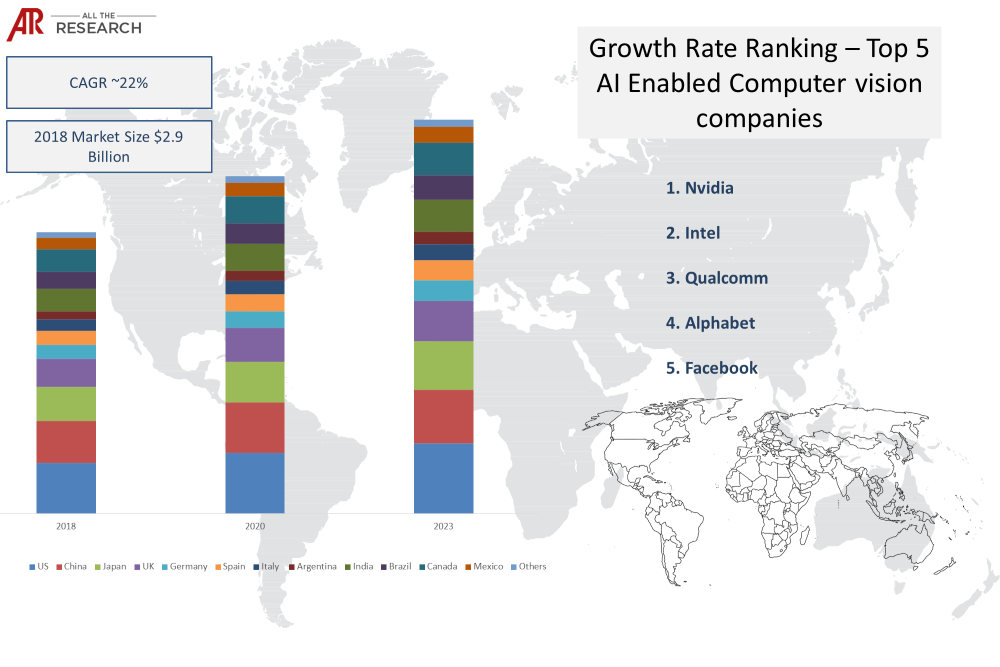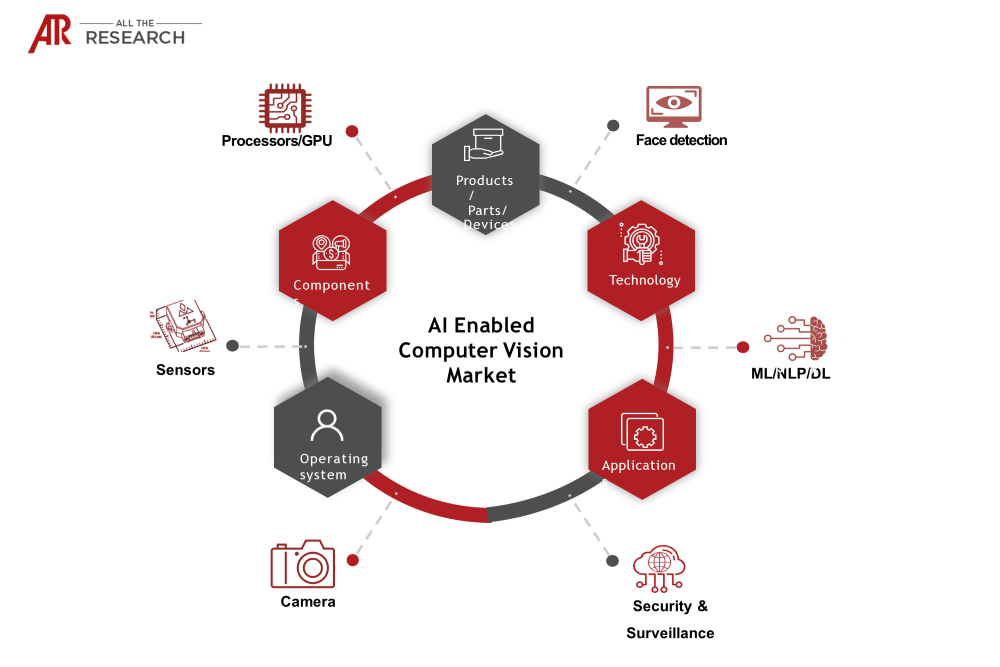Artificial intelligence (AI) is the capability of a computer or a computer-enabled robotic system to manage information and produce outcomes in learning, decision making, and solving problems, in a manner that resemble the thought process of humans. Computer vision is the field of computer science that has focused on replicating the complexity of the human vision system and on enabling computers to identify and process objects in images and videos in the way that humans do. The major driving factor behind the growth of computer vision is the huge amount of data generated in day to day life. The accuracy rates of object detection have been increasing with an increase in new hardware and algorithms in computer vision. From 50% accuracy to 99%, computers are reacting more quickly than humans to visual inputs. Features like Topology for Custom-tailored eyewear, MTailor for making custom fitted pants and shirts, Pottery Barn for virtual look of new furniture at homes with 3D models, self-driving vehicles, and cashier less supermarkets - all are a result of computer vision. There is no end of uses for computer vision. So, the Artificial Intelligence (AI) in Computer Vision Market Ecosystem is expected to witness ~22% CAGR.

The arrival of computer vision technology in smartphones is driven by continued investments in AI techniques by major OEMs like Apple, Samsung, Huawei, and Google. The new generation of smartphones has features like sophisticated cameras with higher resolutions, to capture more data to improve the overall accuracy of visual recognition and to enhance the reliability of facial recognition. Google has worked on the world's first tango-enabled smartphone Lenovo Phab 2 and ASUS ZenFone AR, while Apple has introduced 3D sensing in iPhone X with the front-facing camera. Apple’s move has led to a rush in 3D sensing adoption. All these new technology transformations are possible with the help of computer vision. Computer vision is a booming industry, as this technology is being used in several everyday products. E-commerce companies like Asos, Alibaba are adding visual search features to their websites to make the shopping experience smoother and more personalized. Apple unveiled its facial recognition feature with the latest iPhone. It is a technology that has been made possible through their acquisition of companies like PrimeSense, RealFace, and Faceshift.
|
Device |
Component |
Deployment |
End-use |
|
Smartphones |
Hardware |
Cloud |
Automotive |
|
Drones |
Software |
On-Premise |
Sports and Entertainment |
|
Automotive |
|
|
Consumer |
|
Consumer Electronic |
|
|
Robotics and Machine Vision |
|
Others |
|
|
Healthcare |
|
|
|
|
Security and Surveillance |
|
|
|
|
Agriculture |
|
|
|
|
Others |
North America is growing in the AI in Computer Vision ecosystem across various industry verticals, mainly in manufacturing and automotive industries. Ford is using AI in the manufacturing process and operations of automobiles. The 2020 Ford Edge model will have artificial intelligence as part of its all-wheel-drive system. The integration of surveillance systems with video analytics solutions is one of the major drivers for the market in this region. Advancement in medical care services in the Asia Pacific market is rapidly increasing the use and adoption of computer vision for accurate and quick medical reports, radiology and, or measuring the blood lost during surgeries, majorly during c-section procedures. Government funding and investments in Artificial Intelligence is increasing in this market. In 2017, the US social media platform Pinterest launched its visual search tool “Lens” as discovery engine on its mobile app. The company partnered with retail giant Target to integrate Pinterest’s Lens into the target.com e-commerce platform, in order to help customers, find items of interest through images. In the U.S. 529 startup companies have been listed under the label of computer vision. The average valuation of these companies is at $5.2 M each. These companies will soon raise between $5M and $10M in different stages of funding. Huge investments are being undertaken all over the world for computer vision development.

There are many trends that are having an impact on the market forecast. These, when evaluated from a company’s perspective, can drive growth. Our numerous consulting projects have generated sizeable synergies across all regions and all sizes of companies.
The major players operating in the Global AI in Computer Vision ecosystem are as follows:
|
Company |
Ecosystem Positioning |
Total Revenue (US$) |
Industry |
Region |
|
Nvidia |
Software & solution |
US$11.7 Billion |
Semiconductors |
Global |
|
Intel |
Software & solution |
US$70.8 Billion |
Semiconductors |
Global |
|
Qualcomm |
Software & solution |
US$22.73 Billion |
Semiconductors |
Global |
|
Alphabet |
Software & solution |
US$136.82 Billion |
Semiconductors |
Global |
|
|
Software & solution |
US$55.838 billion |
Social media and Advertising |
Global |
Very few markets have interconnectivity with other markets like AI. Our Interconnectivity module focuses on the key nodes of heterogenous markets in detail. Smartphones, Hardware, Cloud, Drones, Software, and On-Premise markets are some of our key researched markets

|
Trends |
Device |
Component |
End-use |
Impact on Market |
|
The use of computer vision along with machine learning algorithms allows insurance companies to automate the claim process. Insurance agents can upload images associated with the claim, such as those of damaged car and how much they think the client should receive as a payout based on the photographed images. AI then compares the uploaded images in the database of images with varieties of damages and the payouts associated with them. |
Automotive |
|
Automotive |
0.30% |
|
Gun shooting incidents at public places have become more prevalent over the years. Artificial intelligence embedded in surveillance cameras, along with computer vision and machine learning, can help detect the location of the gunman and share the same with the law enforcers. This can help prevent a mass shooting before it happens. Developed economies such as the U.S. and Germany, among others, are using this technology to spot the gunman’s location. |
|
Hardware |
Security and Surveillance |
0.61% |
|
AI-based waste management helps achieve zero waste city by monitoring trashes using cameras and guiding to the nearby dustbins. Each dustbin has a QR code and the users get money if some metal trashes are found. It uses computer vision to detect and classify the waste. Once the trash is full, a message is automatically sent to the corporation for replacing the bin. |
Consumer electronics |
|
Others |
XX |

Ask for free product review call with the author

Share your specific research requirements for a customized report

Request for due diligence and consumer centric studies

Request for study updates, segment specific and country level reports
